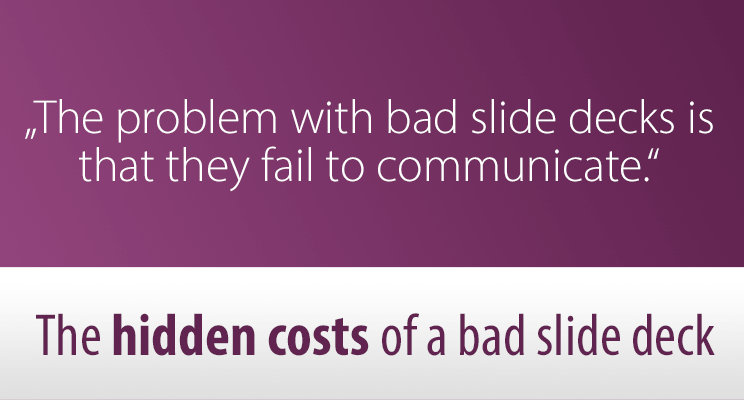How poorly designed slide decks can have devastating consequences in the pharma industry
Slide decks are the de facto standard in pharma. And they aren’t all bad. At their best, slide decks can bring together graphics, text, and data in a versatile medium that is easy to transfer. They can serve as briefs for projects, presentations for training, or scientific platforms for internal alignment on product claims. The uses vary as widely as the quality of slide decks. Some are well-structured and wonderfully designed, while others are pure horror for the audience. At their worst, slide decks can be damaging for the author, the product, and the company.
Money can be burned in the business world by wasting time, falling short of goals, and making the wrong decisions, and with bad slide decks, you can achieve all three.
Let’s have look at the top five ways bad slide decks cost pharmaceutical companies serious money, in order of financial impact.
#5: A bad slide deck requires the same amount of effort as a good one (but it costs more).
Though endless hours of work are spent to create slide decks, many of them still don’t reach their intended goal because they fail to inform or convince the target audience. This is sad and unnecessary. An ineffective slide deck can quickly turn into a time and money pit. Not only does the initial effort not pay off. It takes more time and money to keep reviewing and reworking bad slides. Applying some basic design rules from the start can make all the difference and at minimal cost. When looking at the ROI, good design is a good investment, while bad design can burn a hole in your pocket.
#4: Bad slide decks waste your audience’s time.
A basic rule for the creation of slide decks is “keep the needs of your audience in mind.” One basic need they have is quickly find and understand the information your audience looks for. If they need to spend more time than necessary to figure out what you want to say, you’re wasting their time. This also means a waste of money.
#3: Bad slide decks can foster misconceptions.
The human brain is hard-wired to detect patterns and structures in everything we encounter. To make sure that your intended message comes across, you need a clear, logical structure and visually recognizable patterns. If the information is organized in a way that is unintuitive and if the visuals are confusing or inconsistent, the audience will need to structure the information for themselves. This elevates the risk for fundamental misconceptions. The later rounds of discussion needed for clarification will eat up considerable time. The questions and false impressions can linger for months or even years before they are addressed. In the meantime, productivity plummets.
#2: Bad slide decks jeopardize your reputation and your business relationships.
One way to frustrate colleagues or business partners is to make them search for information. Another way is failing to communicate messages clearly. Both can have devastating effects on your reputation and your business relationships.
Partners may perceive the quality of a slide to reflect the quality of the data being presented. Is that chart grainy because it’s a low resolution screenshot, or does the presenter have something to hide? Moreover, the viewer unconsciously draws conclusions from the quality of the presentation about the competence of the author or presenter and about the quality of the product.
The result? Maybe it’s a manager, who now underestimates an employee’s skills and intelligence. Or maybe physicians and regulatory authorities reject your recent study results and decide not to recommend a product. The danger is real and the costs are high.
#1: Bad slide decks can leave too much room for misinterpretations, leading to disastrous strategic mistakes.
Slide decks are perfect tools to communicate study data and medical insights. In that way, they influence the thinking of their audience and encourage them to act on what they’ve learned. One common target group for slide decks are executives, who are responsible for business strategies and product development strategies.
Nancy Duarte writes in her most recent book DataStory, “Executives must constantly make decisions based largely upon data analysis. They want it presented to them in an expert manner.”
Medical affairs executives and medicals advisors in product teams carry a huge responsibility not only for the company, but also for the health of patients. Decisions based on misinterpreted information and data can mean financial catastrophe for the whole company. And it can put patients at risk.
It would be tragic if a promising treatment that could help patients failed to reach the market because a slide deck failed to do its job: communicate costs, risks, and benefits clearly and to the point.
Overall, the problem with bad slide decks is that they fail to communicate. The signal doesn’t get through the noise. Making a bad slide is like writing a letter with white ink on white paper or giving a speech with your back to the audience and a bag over your head. It’s setting the audience up to misunderstand what you want to say. Every misunderstanding costs time and money. But by following some basic principles of design, learning theory, and logical organization, these costs and the misunderstandings that drive them can be avoided.

You have problematic slides in your deck?
If you are a leader in pharma or biotech, send us the most problematic slide in your deck: we will rework it and come up with suggestions for improvement. This service is free of charge and without any obligation for you!

